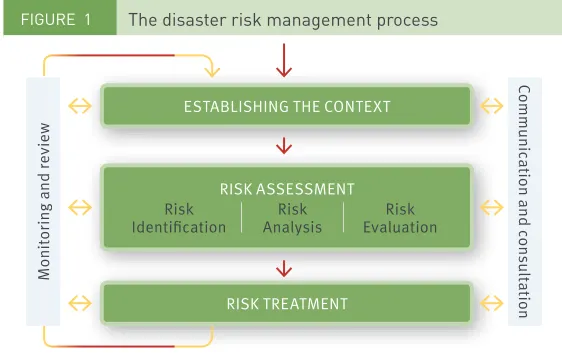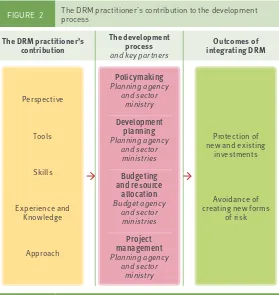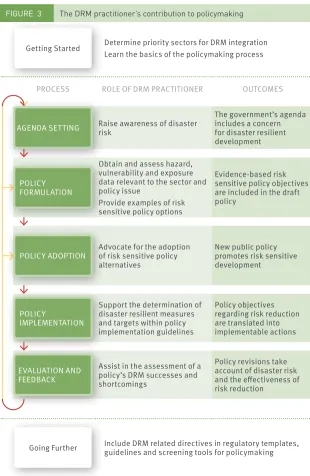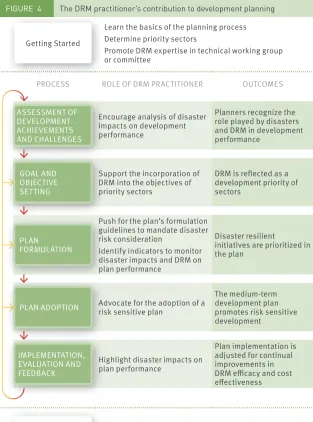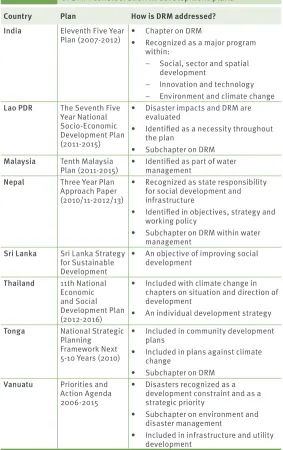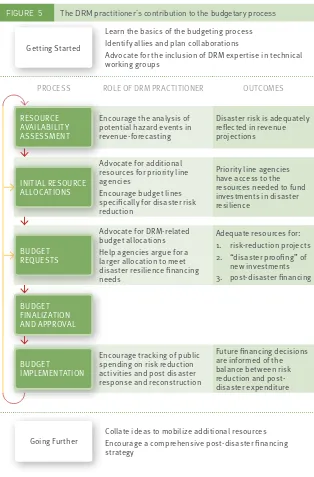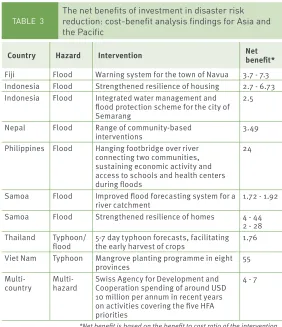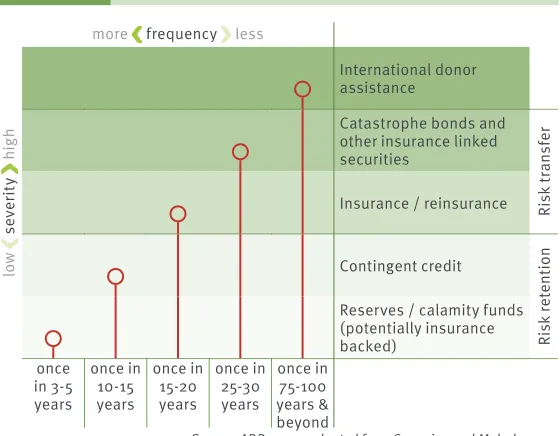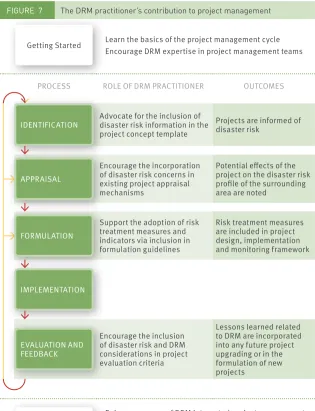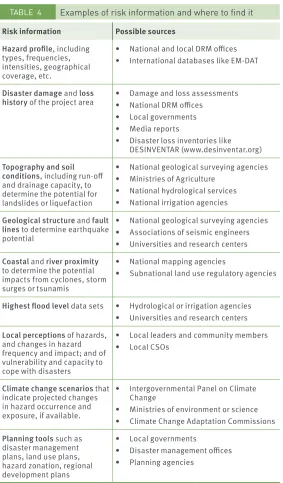IntegratIng DIsaster rIsk ManageMent
Into the
DEVELOPMENT PROCESS
DIsaster rIsk ManageMent
ISBN 978-616-91716-2-1
This publication may be freely quoted but acknowledgement of the source is requested.
Citation
ADPC. 2013. Integrating Disaster Risk Management into the Development Process. Disaster Risk Management Practitioner’s Handbook Series. Bangkok.
Cover Photo
IntegratIng DIsaster rIsk ManageMent
Into the
DEVELOPMENT PROCESS
Disaster risk management
ii Drm Practitioner’s HanDbook series
acknowleDgments
Integrating Disaster Risk Management into the Development Process is the result of a collaborative, multistakeholder effort over the course of 2011-2013, drawing upon the knowledge and experience of many organizations and individuals across Asia and the Pacific.
The handbook was developed by the Asian Disaster Preparedness Center (ADPC), with funding from the Asian Development Bank (ADB). Ian Davis, Oxford Brookes University, and Brianna Hunt Ficcadenti, ADPC, edited the handbook, with support from the ADPC writing team: Atiq Kainan Ahmed, Senaka Basnayake, Marino Deocariza, Rowan Fraser, Gabrielle Iglesias, Lucy Pearson, Arghya Sinha Roy and Kondokher Golam Tahwid.
integratingDrm into tHe DeveloPment Process iii
Menon, Mohan Sajnani, and Emmanuel Torrente. Numerous other ADPC staff kindly provided material and comments, in particular Rohan Cooray, Alex Fowler, Sudhir Khumar, and John Lindsay. Padma Lal conducted an external review of the manuscript.
The handbook was developed under the overall guidance of Neil Britton, ADB, with technical oversight provided by Iftekhar Ahmed, RMIT University; Charlotte Benson, Consultant; and Bharat Dahiya, Consultant. Technical advice was provided by Madhavi Ariyabandu, UNISDR; U.W.L. Chandradasa, Disaster Management Center of Sri Lanka; Suprayoga Hadi, National Development Planning Agency of Indonesia (BAPPENAS); Susan Rachel Jose, formerly of the National Development and Economic Authority (NEDA) of the Philippines; and Filomena Nelson, Disaster Management Office of Somoa.
Christine Apikul provided copyeditting and Lowil Fred Espada graphically designed the handbook in addition to sourcing photographs.
integratingDrm into tHe DeveloPment Process v
contents
SECTION 1 Introduction
1
1.1 About the series
3
1.2 About this handbook
5
SECTION 2 The DRM Practitioner and the Development Process
7
2.1 The DRM practitioner
11
2.2 The DRM practitioner’s contribution to development
12
2.3 The public development process
18
2.4 The outcomes of integrating DRM
20
SECTION 3 Integrating DRM into the Development Process
25
3.1 Integrating DRM into public policymaking
27
Case Study: Policy formulation protocol promotes safe and sustainable development in Bhutan
41
3.2 Integrating DRM into development planning
45
Case Study: The increasing integration of DRM into medium-term development plans in the Philippines
47
Case Study: The 2007 national physical plan of Sri Lanka
50
3.3 Integrating DRM into budgetary processes and resource allocations
67
Case Study: Budget allocation vs. implementation in Indonesia
82
3.4 Integrating DRM into development projects
89
Case Study: How Lao PDR has integrated disaster risk concerns into EIA guidelines
102
SECTION 4 Conclusion
111
References
114
integratingDrm into tHe DeveloPment Process 1
IntroDuctIon
integratingDrm into tHe DeveloPment Process 3
1.1 about the serIes
The Disaster Risk Management Practitioner’s Handbook Series
portrays what the disaster risk management (DRM) practitioner can contribute to a selection of government-led processes in order to strengthen disaster resilience and foster sustainable, inclusive development across Asia and the Pacific.
Governments in the region have recognized that reducing underlying vulnerabilities and exposure to natural hazards is critical to achieving sustainable development. There is an increasing call to integrate the management of disaster risk into all public and private activities. As such, DRM practitioners are increasingly expected to support the integration of DRM within the many stages of development.
Accordingly, the handbooks aim to provide advice to the DRM practitioner on both strategic and practical options for operational implementation of DRM within a selection of development processes and tools. The advice contained in the handbooks draws on the experience and knowledge of a wide range of DRM and development practitioners with experience across Asia and the Pacific.
The series is comprised of three complementary handbooks:
Integrating Disaster Risk Management into the
DevelopmentProcess
Integrating Disaster Risk Management into Urban Management
Integrating Disaster Risk Management into
4 Drm Practitioner’s HanDbook series
The handbooks specifically address those DRM practitioners who are government officials and have the role or responsibility to manage or reduce disaster risk. As such, the practitioner may be a member of a national or subnational DRM agency, or an officer within a line ministry or subnational authority who has been charged with the responsibility for DRM within the agency’s scope of work.
For DRM practitioners who are familiar with integrating DRM, the handbooks can function as an aide memoire. For practitioners with less experience, the handbooks can act as a guide as to how they can best direct their efforts. For officials engaged in development planning, urban management and climate change adaptation, the handbooks will provide insight into how they can benefit from the contributions of the DRM practitioner.
A note on cross-referencing
Each handbook can be used alone or in combination with the other two. It is hoped that the practitioner will ind each handbook to be complete within the scope of the topic. However, in order to facilitate a greater understanding of the topic under discussion, the practitioner is invited to follow-up on the systematic cross-referencing found throughout all three handbooks. The three handbooks will be respectively cross-referenced as
integratingDrm into tHe DeveloPment Process 5
1.2 about thIs hanDbook
Integrating Disaster Risk Management into the Development Process promotes the adoption of a DRM approach to development decision making in order to both protect public investments from the impacts of natural hazards as well as prevent them from exacerbating the existing risk profile of communities and assets.
This handbook specifically addresses those DRM practitioners who sit within:
the National Disaster Management Agency; or
a sector agency or local government authority and have the designated responsibility for DRM.
This handbook provides DRM practitioners with advice for intervention in four key development processes: public policymaking, development planning, budgeting and resource allocation, and project management. To that end, the handbook explicitly identifies DRM entry points into the general stages of the aforementioned processes, guiding the practitioner on how to support government authorities to consider and treat disaster risk. The handbook aims to:
provide the DRM practitioner with the confidence to engage with government officials for risk sensitive development;
supply the practitioner with sound arguments to be used in advocating for the integration of DRM;
detail the approaches, strategies, tools and activities for achieving comprehensive integration of DRM into the designated development process; and
6 Drm Practitioner’s HanDbook series
In Section 2, the handbook gives an overview of the DRM practitioner and his or her contribution to safe and sustainable development. This section outlines the relationship between disasters and the development process in Asia and the Pacific, and discusses the information, skills and partners required for the successful integration of DRM. The section concludes with the anticipated outcomes of integration and the expected benefits for development in Asia and the Pacific.
Section 3 provides the DRM practitioner with detailed strategic and operational advice on how to integrate DRM into the stages of public policymaking (Chapter 3.1), development planning (Chapter 3.2), budgeting and resource allocation (Chapter 3.3), and project management (Chapter 3.4).
integratingDrm into tHe DeveloPment Process 7
the DrM PractItIoner anD
8 Drm Practitioner’s HanDbook series
PEOPLE’S REPUBLIC OF CHINA. In 2008, a magnitude 8.0 earthquake in Sichuan killed over 87,000 people and caused USD 85 billion in damage. Many hospitals and schools, most of which were relatively new, collapsed while fully occupied.
PAKISTAN. Floods from the Indus River in 2010 resulted in almost 2,000 deaths and losses of more than USD 10 billion. A large irrigation system that converted wetlands to farmlands promoted the location of homes and livelihoods
in the loodplains, increasing the exposure of the population to the loods.
MYANMAR. The 2008 Cyclone Nargis damaged 50-60% of the schools in the Yangon and Ayeyawardy districts; inadequate maintenance was a major contributing factor. While the Ministry of Education adopted maintenance procedures prior to the cyclone, limited budget allocation for school maintenance restricted regular upkeep of the buildings.
AUSTRALIA. In the booming coal-mining town of Emerald, whole suburbs, which were built on a lood plain thought to rarely lood, were under meters of water after the high intensity 2010-2011 Queensland loods. With beliefs that La Niña patterns could continue to intensify due to climate change, there are now fears that the suburbs will experience heavy looding regularly.
integratingDrm into tHe DeveloPment Process 9 Development in large part determines how hazards impact people
and economies.
(UNISDR and WMO, 2012)
Since the 1970s, Asia and the Pacific has seen remarkable development progress in a variety of sectors in many countries, including rapid economic expansion, social transformation, increased access to health and educational services and infrastructure development. In the same period, disasters have resulted in a steady loss of life and a gradual increase in physical losses, correlating to the region’s economic growth and infrastructure expansion (ADB, 2013). These losses, and the related setbacks in poverty alleviation and socio-economic progress, are not inevitable; they are often the partial result of development decisions taken without appropriate consideration of the potential impacts of natural hazards.
While disasters have a clear negative impact on development, the relationship is not one sided. The development choices made in many countries in the region have led to increased vulnerability and exposure of communities and assets to natural hazards. According to the World Bank, factors such as urbanization and environmental degradation, in addition to climate change, have increased the severity and rate of disasters by more than 400 per cent since the 1980s (World Bank, 2013).
10 Drm Practitioner’s HanDbook series
tHe Disaster risk management
Practitioner PlaYs an imPortant
role in acHieving sUstainable
DeveloPment bY Facilitating tHe
assessment anD treatment oF
Disaster risk witHin tHe Processes
integratingDrm into tHe DeveloPment Process 11
2.1 the DrM PractItIoner
The DRM practitioner is an individual whose professional function includes contributing to the management of disaster risk within a sector, geographic area or organization. Some practitioners dedicate themselves full time to managing disaster risk, such as a Program Officer based in a country’s National Disaster Management Agency, or a DRM officer located in a sector line agency. Other practitioners may be appointed as DRM focal point within a government agency, yet their responsibilities are not limited to DRM. For example, an Engineering Officer within the department for school construction may be the DRM focal point for the education sector in a particular country. Box 1 describes what the DRM practitioner does, with whom, how, and why.
boX 1 the DrM practitioner
The DRM practitioner works …
for municipal, subnational or national government agencies
on • reducing disaster risk where possible • managing the remaining disaster risk
with • government agencies and departments • DRM or climate change adaptation focal points • at-risk communities and civil society organizations • universities and other research oriented organizations • bilateral and multilateral development partners • private businesses and the media
by using appropriate risk information to afect changes in: • knowledge and awareness • plans and policies • activities and behavior • programs and budgets • technical capacity • institutional arrangements • political commitment • management tools and systems
to • protect communities, assets and livelihoods from the adverse
impacts of natural hazards
12 Drm Practitioner’s HanDbook series
Regardless of the extent of technical DRM training they have received, DRM practitioners are uniquely positioned to contribute to the achievement of safe, sustainable and equitable development.
2.2 the DrM PractItIoner’s contrIbutIon
to DeveloPMent
DRM aims to avoid, reduce or transfer the adverse impacts of natural hazards on people, property and the environment through activities and measures for prevention, mitigation and preparedness. It involves undertaking a logical and sequential process for the judicious design, implementation and evaluation of strategies, policies and measures that aim to:
understand disaster risk, considering hazards, exposure and vulnerabilities;
reduce disaster risk through measures that aim to protect lives and assets;
promote disaster preparedness, response and recovery practices; and thus
facilitate and advance sustainable development (IPCC, 2012).
integratingDrm into tHe DeveloPment Process 13
PERSPECTIVE | The DRM practitioner thinks about natural hazards and looks at things from a risk perspective. This perspective is concerned with reducing the potential loss of lives and assets and thereby ensuring safe, healthy, and productive communities. Colleagues from other fields will bring different perspectives to the development processes; each makes a contribution towards the achievement of sustainable, inclusive development.
TOOLS | The DRM practitioner uses specific tools, some of which are unique to the DRM field, in order to achieve the aim of reducing risk and managing residual risk. Tools the DRM practitioner might use include spatial analysis software, risk assessment methods, and public policies.
SKILLS | Use of the tools mentioned above requires a specific skill-set that the DRM practitioner may learn through structured trainings, self-directed study and job experience. These skills can include public outreach and persuasion, technical analysis and planning.
EXPERIENCE AND KNOWLEDGE | The practitioner can influence development by drawing upon personal experience and examples from around the region of sound DRM practices as well as the consequences of development actions that ignore disaster risk. For this reason DRM practitioners should be sure to record, document and disseminate their experiences, particularly for use in training and orientation of new practitioners.
APPROACH | To manage risk, the practitioner takes a DRM approach to their work, following a continuous process of gathering and analyzing risk information, identifying which risk can be reduced, and how to manage the remaining risk. The integration of DRM involves embedding the stages of this risk management process within the relevant stages of development processes.
14 Drm Practitioner’s HanDbook series
implementation, an internationally recognized and followed process for comprehensively and systematically managing risk. The process consists of the following five stages:
1. Communication and consultation. A continual discussion with communities and public officials carries on throughout the DRM process. Generally, it ensures that all stakeholders both understand and contribute to the conversation regarding disaster risk. Issues include disaster impacts, the need for DRM, identification of risks, agreement on the level of acceptable risk, and the risk management measures required.
2. Establishing the context. In this stage, the social, cultural, political and economic environment within which DRM will be implemented is defined. This includes understanding: the responsibilities and capacities of government organizations; the role played by private and civil society organizations (CSOs); and how decisions are made. During this context analysis, the criteria are set for determining acceptable levels of risk, or the amount of risk a particular society is willing to allow.
FIgure 1 the disaster risk management process
M
integratingDrm into tHe DeveloPment Process 15
3. Risk assessment. The overall technical, economic and social process of risk identification, risk analysis and risk evaluation is undertaken during the risk assessment stage. It involves technical professionals (social scientists, engineers, economists, urban planners etc.), as well as representatives of affected sectors and communities. Risk assessments identify historical and potential future hazards; study past impacts and the underlying drivers of risk; examine social, economic and environmental vulnerability as well as the exposure of people and assets to the hazards; consider the capacity of the society to deal with potential impacts; analyze the potential frequency and intensity of future consequences; and evaluate whether the existing level of risk meets the criteria for what is acceptable.
Methods for risk assessment can be top-down, quantitative and driven by hard data, or they can be participatory and seek a more qualitative understanding of risk. Ideally they are both. The general components of any risk assessment are detailed in Box 2 on page 16.
Perhaps the most challenging aspect of undertaking a risk assessment is gathering the necessary data. The data required for a quality risk assessment will have to be collected from various sources, such as national DRM offices; government line agencies and statistical offices; meteorological, hydrological or seismological agencies; research institutes and universities; international development partners and local community groups. Acquiring sufficient and appropriate data can be a challenge, as often datasets will be incomplete, outdated or even nonexistent.
16 Drm Practitioner’s HanDbook series
The information generated through risk assessments is crucial to ensuring quality DRM. The more accurate the risk information, the more adequately the risk can be addressed and treated.
4. Risk treatment. Specific measures to reduce or manage risk are identified and implemented during the risk treatment stage. This is a cyclical process of: deciding on the treatment type (whether to reduce existing risk or manage residual risk); identifying the measure; assessing its suitability through testing tools such as computer modeling, pilot projects, drills and simulations; evaluating the effectiveness of the treatment; and modifying or generating new risk treatment until a consensus is reached on the level of risk acceptable.
Risk treatment measures are determined by the context: nature and scope of risk, capacity of stakeholders to implement measures, likely cost and effectiveness of measures, resources available etc. | see page 104 for examples of specific disaster risk treatment measures; URBAN 2.2 and CLIMATE 2.2 provide further examples |
boX 2 risk assessments
Regardless of the method employed or the coverage of the analysis, risk assessments are usually structured around four major steps:
1. Establishing baseline data involves gathering demographic and sector data (such as for the agricultural sector). Data should be understood spatially using Geographic Information Systems, or hand-drawn maps (i.e. data should be geo-referenced).
2. Hazard mapping includes gathering data on historic hazard events and projected future changes in frequency and intensity, as well as the nature and extent of any losses due to the hazard and the afected areas.
3. Vulnerability and capacity assessment involves evaluating communities, businesses, organizations, sectors, structures and systems to measure their susceptibility to loss or damage.
integratingDrm into tHe DeveloPment Process 17
5. Monitoring and review. The DRM process is undertaken so that continual improvements can be made at all stages. The purposes are: to analyze and learn lessons from hazard events, changes and trends; to detect changes in the context including changes to the risk itself, which can require revision of risk treatments and priorities; ensure that the risk control and treatment measures are effective in both design and operation; and identify emerging risks.
Box 3 summarizes the contributions the DRM practitioner can make to facilitate the integration of DRM into the public development process.
boX 3 the DrM practitioner’s contribution to development
Perspective
• Looks at things through a risk lens
• Focuses on reducing disaster risk related to to all current and future hazards
Tools
• Risk assessment methods • Damage and loss
assessments
• Computer-based modeling
• National DRM policies and frameworks • International agreements and
conventions
• GIS-based spatial analysis
Skills
• Advocacy • Awareness raising • Capacity building • Risk communication
• Negotiation • Planning and testing
• Interpreting technical information • Spatial and inancial analysis
Experience and knowledge
• DRM theory
• The practitioner’s own
• Natural hazards and climate change • Sound practice from the region
Approach
• Consultation and communication • Establishing the context
18 Drm Practitioner’s HanDbook series
2.3 the PublIc DeveloPMent Process
Sustainable development has been defined as meeting the needs of the present without impeding the ability of future generations to meet their needs (UN, 1987). The international development agenda emphasize the need for sustainable economic, social and environmental development. Similarly, in recent decades, governments across Asia and the Pacific region have been moving in that direction.
Development takes place within a framework of national and international demands and trends; it is a complex affair. Many actors are involved, including CSOs, local and national government agencies, international aid agencies, national and international private sector organizations and the communities themselves. Public and private agencies often find themselves competing against each other for financial and other resources, as well as power and prestige. Mandates and competencies often overlap and run into conflict.
Managing development within this context is a continually challenging task. Government institutions have a particularly vital role to play in molding, guiding and prioritizing a country’s development trajectory via a number of interlinking processes that stem from political will and strategic planning and lead through to tangible implementation, determining objectives, responsibilities and resources along the way. These development processes are meant to guide the investment of public resources in creating new or maintaining existing programs and projects.
integratingDrm into tHe DeveloPment Process 19
Common development tools:
Policies are a key instrument used by governments to officially address societal problems and steer the development of a country. They are often the result of a political process where public recognition of a problem results in action being taken. Policies can be broad overarching frameworks that set the goals, objectives and guiding principles for public action in an entire sector, like health care policy or a cross-cutting theme such as gender equality. Alternatively, they can be focused on a particular regulatory issue, such as building construction quality.
Development plans cover anywhere from 3-5 years for medium-term plans to 30 years for development visions. They set a vision for the development trajectory of the country and seek to regulate the overall progress, prioritizing among sectors and objectives in order to attain equitable and sustainable development. The level of detail and the types of issues addressed in development plans are the prerogative of government. Some plans are short strategic documents, while others are quite comprehensive documents that detail the program and projects to be undertaken.
Budgets, typically prepared by governments each year, allocate resources for both capital and recurrent purposes over the forthcoming fiscal year, revising and rolling over medium-term expenditure plans to achieve their goals and objectives. As government resources are finite, budgets distribute resources among the many competing demands.
20 Drm Practitioner’s HanDbook series
Development processes should work together, be complementary and form a constantly evolving regulatory system. Effective medium-term development planning will require adequate sector policymaking for programmed implementation. Large capital investment projects such as public infrastructure and utility construction require careful budgeting.
National governments are only just beginning to engage the tools outlined above to consider and address disaster risk; widespread integration of DRM has yet to come. The goal is that by integrating DRM into the tools outlined above, development in Asia and the Pacific will become increasingly resilient to disasters.
To support the effective integration of DRM into the development process, the DRM practitioner can draw upon a reservoir of professional knowledge, experience, tools and skills to embed the stages of the risk management process within the stages followed for policymaking, development planning, resource allocation and project management.
2.4 the outcoMes oF IntegratIng DrM
The effective integration of DRM into the development process results in risk-sensitive development, which has two fundamental outcomes:
integratingDrm into tHe DeveloPment Process 21
Second, integrating DRM seeks to avoid the creation of new forms of risk due to an increase in the exposure or vulnerability of populations and assets. This means, for example, that socio-economic policies will not increase the exposure of populations or assets, like an agricultural policy that encourages farming settlements in an inadequately protected flood plain. It also means that all new physical developments, like rail lines and housing developments, are undertaken with consideration not only of the potential hazard impacts on the asset itself, but also of the potential impacts on the surrounding area. As such, these developments do not exacerbate existing risks or create new ones for nearby communities or assets. Figure 2 summarizes the relationship between the practitioner, the development process and the outcomes of integrating DRM.
FIgure 2 the DrM practitioner’s contribution to the development
process
The DRM practitioner’s contribution new and existing
investments
Avoidance of creating new forms
22 Drm Practitioner’s HanDbook series
The DRM practitioner contributes to the achievement of these outcomes by facilitating and enabling the management of disaster risk within the processes that guide public development investments.
While all development activities should aim to achieve these joint outcomes, they will not be attained overnight. Just as the development and DRM processes themselves are iterative, so is the process of integrating the two. The task of the DRM practitioner is great, but not impossible. It will require patience, persistence, enthusiasm and an interest in making the world safer for present and future generations.
boX 4 Words from the ield
Mr. Jotham Napat, Director of Vanuatu’s Meteorological Services and Chairman of the National Advisory Board on Climate Change Adaptation (CCA) and Disaster Risk Reduction, shares his insights on the challenges of integrating:
Dedication and persistence have been the key to success. We’ve just kept on going. We’ve had to be very proactive in order to get this to happen. You need to be strong and pioneering to really make a change. Driving this forward has been hard work.
One of the key strategies that I’ve used in this work is presenting only the right type of information when I deal with top level people. For example, if you’re trying to convince the inance sector of the importance of DRM, you need to show them inancial losses of disasters. If it is the social protection departments, show them social losses. Above all, information that you present has to be fact driven and evidence based. This is so important.
IntegratIng DrM Into the
DeveloPMent Process
26 Drm Practitioner’s HanDbook series
integratingDrm into tHe DeveloPment Process 3.1 27
chapter 3.1
INTEGRATING DRM INTO
PUBLIC POLICYMAKING
overvIeW
Establishing a risk sensitive policy environment supports effective integration of DRM into the broader development process. Public policy is a primary instrument used by governments to officially address societal problems and steer the development of a country. While public policy is an intrinsically fluid and broad term that refers to all government decisions about public management, formal public policies are frequently long-term, overarching frameworks that set the goals, objectives and guiding principles for public action. Public policy development is the principal method used by governments to highlight priority issues and direct resources towards them.
A public policy, often formalized as legislation, is developed by government officials and agencies, and typically affects considerable numbers of people (Anderson, 2003). A single public policy can either address an issue related to a specific sector (i.e. health care policy), or it can span several sectors (i.e. natural resource management policy, which affects agriculture, fish and game, environmental management, forestry, mining, etc.). Public policies are not restricted to national levels; depending on the size and level of decentralization in a country, relevant policies may be designed at subnational levels.
28 Drm Practitioner’s HanDbook series
setting the stage for risk resilient socio-economic development. The integration of DRM into the policymaking process facilitates the systematic consideration and adoption of risk resilient policy options or alternatives. When effectively implemented, the risk resilient objectives are translated into sector-specific policy responses, budgets and, ultimately, action.
While the DRM practitioner is not expected to take an active role in the political aspects of policymaking, the practitioner can play a part in:
supporting the technical aspects of public policymaking in the assessment of risk information and development of risk resilient policy options; and
providing robust up-to-date information of the impacts of disasters on sector development, the impacts of development policies on disaster risk, and the benefits of incorporating risk reduction into policies in order to inform policy formulation.
the goals oF the DrM PractItIoner
By engaging in the public policymaking process, the DRM practitioner aims to ensure that:
goals and targets that will not be potentially thwarted by natural hazard events are adopted in sector policies and responsibilities to ensure implementation are assigned; and
integratingDrm into tHe DeveloPment Process 3.1 29
FIgure 3 the DrM practitioner’s contribution to policymaking
Getting Started Determine priority sectors for DRM integration Learn the basics of the policymaking process
PROCESS ROLE OF DRM PRACTITIONER OUTCOMES
AGENDA SETTING Raise awareness of disaster
risk
The government’s agenda includes a concern for disaster resilient development
POLICY FORMULATION
Obtain and assess hazard, vulnerability and exposure data relevant to the sector and policy issue
Provide examples of risk sensitive policy options
Evidence-based risk sensitive policy objectives are included in the draft policy
POLICY ADOPTION
Advocate for the adoption of risk sensitive policy alternatives
New public policy promotes risk sensitive development
POLICY
IMPLEMENTATION
Support the determination of disaster resilient measures and targets within policy implementation guidelines
Policy objectives regarding risk reduction are translated into implementable actions
EVALUATION AND FEEDBACK
Assist in the assessment of a policy’s DRM successes and shortcomings
Policy revisions take account of disaster risk and the efectiveness of risk reduction
30 Drm Practitioner’s HanDbook series
gettIng starteD
Given limits to time and resources, the DRM practitioner may choose to begin by determining which sectors and policy issues to focus efforts and prioritize for DRM integration. In practice, policymaking is a continual process, with policies periodically coming up for review. The DRM practitioner can pre-identify important areas and then keep abreast of the latest news on planned reviews and determine on a case-by-case basis when to get involved. There may be periods where there are no policies of particular relevance under review, while at other times the practitioner may have to make deliberate choices to engage in the formulation of certain policies over others. Identifying policies up for review should be a continual process.
Those practitioners that are seated within a national disaster management agency can begin by analyzing which sectors are most vulnerable to disaster impacts. The analysis could be in terms of direct financial losses and service interruption caused by the disaster, or the channeling of funds from development activities to disaster response and recovery. Additionally, the analysis may identify those sector activities that most contribute to disaster risk. For example, school construction without seismic resistant design leads to increased vulnerability to earthquake hazard of both the state asset and the current and future communities who use the building.
integratingDrm into tHe DeveloPment Process 3.1 31
one or two provinces, a national scale assessment (i.e. 1:50.000) will be of limited value. | see Box 2: Risk assessments on page 16 for more information |
Alternatively or in addition, if time and resources allow, the DRM practitioner can facilitate a national dialogue, engaging key stakeholders such as sector agencies, civil society, private sector and, where possible, local populations, to ensure that their viewpoints and concerns are duly noted. The more thorough the dialogue, the more useful it will be. To guide this dialogue, the following questions might be asked (adapted from UNDP and UNEP, 2011):
How have disasters impacted key development goals of the country? How have current development patterns impacted disaster risks? What may happen in the future?
Which sectors, population groups and regions are most vulnerable to the potential consequences of climate and disaster risks? What are the underlying reasons for their vulnerability (e.g. poverty, degraded natural resources, poor standards of physical development)?
What has been done, if anything, to reduce disaster risks? Has it been effective? If not, why?
Box 5 on page 32 describes sector prioritization as undertaken in Nauru.
32 Drm Practitioner’s HanDbook series
Policymaking bodies typically have a set of procedures that enable systematic and rational policymaking, where advocates from all sides of an issue have an opportunity to present their arguments. The fundamental aspects of the process, including the key players, can be quickly learned through a short meeting with a mid-level officer from the national planning agency, and mid-level officers from other sector agencies who are familiar with policymaking for their institution. The practitioner can seek information (including documentation) to answer the following questions (Adapted from UNDP and UNEP, 2011):
Who has the overall mandate to coordinate policy design (i.e. national planning agency; national budget and finance agency), and are they normally involved in sector level planning processes and multi-sector policymaking?
What are the overarching policy priorities that the government is committed to (i.e. poverty reduction; economic growth, etc.)? How can an argument be made that this requires integrating DRM into sectors?
boX 5 Prioritizing climate sensitive sectors in nauru
In order to determine priority sectors to target for integrating climate change concerns, Nauru chose to follow a process led by stakeholders to rank sectors in terms of sensitivity to climate change. A group of key stakeholders collectively identiied criteria for prioritization, loosely following the suggestions set forth by the United Nations Framework Convention on Climate Change. A sample of these prioritization criteria utilized included:
• severity of the adverse efects of climate change on the sector; • cost-efectiveness, feasibility and long-term sustainability of potential
interventions; and
• potential to enhance community resilience and adaptive capacity.
integratingDrm into tHe DeveloPment Process 3.1 33
What are the individual mandates, structures and decision-making processes in key sectors? (Individual sectors may be structured quite differently i.e. have different levels of decentralization)
What policies exist in key sectors? Are there relevant policy initiatives underway?
suPPortIng DrM InForMatIon anD
knoWleDge reQuIreMents
Policymakers require information regarding national and international commitments to support the formation of disaster resilient public policies:
International DRM and climate change adaptation (CCA) agreements provide a mandate and rationale for integrating DRM into sector policy. The actions of governments can be influenced by these international commitments. The DRM practitioner can draw upon global conventions and regional frameworks agreed to by their country, such as the Hyogo Framework for Action (HFA), ASEAN’s 2005 Agreement on Disaster Management and Emergency Response or SOPAC’s Pacific Disaster Risk Reduction and Disaster Management Framework for Action, 2005-2015. The practitioner can also take advantage of any commitment made for minimum investments in disaster risk reduction to support the argument to incorporate DRM investments in development policy.
34 Drm Practitioner’s HanDbook series
the DrM PractItIoner’s contrIbutIon to
the PolIcYMakIng Process
ROLE OF DRM PRACTITIONER OUTCOMES
AGENDA SETTING Raise awareness of disaster risk
The government’s agenda includes a concern for disaster resilient development
The policymaking process begins with the identification of public problems. Societal conditions convert into problems when the public deems the condition to be unacceptable and considers that the government can remedy the situation. The government decides which issues to formally address, prioritizing from among the many demands for public attention.
integratingDrm into tHe DeveloPment Process 3.1 35 ROLE OF DRM PRACTITIONER OUTCOMES
POLICY FORMULATION
Obtain and assess hazard, vulnerability and exposure data relevant to the sector and policy issue
Provide examples of risk sensitive policy options
Evidence-based risk sensitive policy objectives are included in the draft policy
Policy formulation is the process of deciding on the aims and objectives for addressing the broad goals that government has placed on the policy agenda. In this stage, the government creates, identifies or borrows proposed courses of action, often called alternatives or options, for resolving or ameliorating public problems.
To guide the policy formulation process, a committee of legislators and other public officials is often formed. This committee is responsible for hearing all the relevant testimony and making decisions based on the evidence. It is highly likely that policymakers will request technical testimony from various line agencies. Should the DRM practitioner be called to testify about the disaster risk facing the particular policy issue, it is a prime opportunity for the DRM practitioner to stress the impact of disasters and the importance of DRM.
In this testimony, the DRM practitioner can argue that disaster risk is affecting development in the particular policy area in order to justify investment in DRM. If available, the DRM practitioner could draw upon a sector risk assessment of the current and estimated future impacts of natural hazards on the particular sector, or any post disaster assessments of hazard impacts on the sector. This information base will allow the DRM practitioner to suggest possible evidence-based measures for risk reduction.
Where they exist, the DRM practitioner can also draw upon an
36 Drm Practitioner’s HanDbook series
the economic implications of disasters on individual sectors. Additionally, it can help define the most realistic and cost-effective risk reduction measures within budgetary possibilities. For example, the Government of Fiji analyzed the economic costs of the 2009 floods on sugar cane production, Fiji’s main primary industry, in order to highlight the impact such hazards have on local economies. This analysis served to build an argument for a systematic approach to reducing disaster risk in the country ( Lal, 2010).
Depending upon the sector being analyzed and the potential for climate change to affect the sector’s risk profile, this may require more sophisticated and complex modeling and analysis. Many international organizations are interested to work with local agencies to perform these kinds of economic analyses, provided the local agency has the resources to provide sufficient data.
Additionally, local pilot demonstration projects that test the effectiveness of DRM measures in specific sectors can foster interest and commitment at both the subnational and national levels. DRM practitioner can use their own knowledge and experience on projects in the country, as well as the Internet to research international examples, and catalogue relevant lessons learned to present in testimony. It is not necessary that the demonstration project was a success; well-documented and analyzed “failures” can also be very informative for policy formulation.
integratingDrm into tHe DeveloPment Process 3.1 37
Remember that the mere presentation of facts on the impact of disasters, underlying causalities and expected future trends is not sufficient to convince decision makers to make the policy disaster resilient. Integrating DRM into policy is not just a technical but also a political process. As such, it is not clear-cut, but often subject to conflicting interests and opinions. Policy measures that have the potential to result in local zoning and occupancy or building restrictions may provoke strong opposition. While presenting evidence is crucial, and can help to generate support for integrating DRM, perceptions and opinions are just as, if not even more important. The challenge is to use the evidence in such a way that it engages potential partners, influences opinions and generates political commitment.
In some countries, DRM expertise is not consulted during the initial policy formulation process, but the DRM practitioner is asked to screen the policy for disaster resilience after the policy proposal has already been identified. In many countries, policy proposals are in the form of a concept paper or draft policy that puts forward the main issues the policy is to tackle. These papers provide a good opportunity to reflect the specific risks the sector is subjected to or outline the disaster risks the sector may inadvertently bring about if no preventive measures are taken.
boX 6 checklist of DrM considerations for policy components
• Which hazards are of particular relevance to the sector?
• Does the proposed policy demonstrate active consideration of relevant disaster risks associated with these hazards?
• Will the proposed policy increase vulnerability to hazards?
• Does the proposed policy include measures to decrease current and expected future vulnerability to hazards?
• Are the institutional responsibilities and resources for managing disaster risk speciied in law?
38 Drm Practitioner’s HanDbook series
Should this be the case, using the information from the sector-specific risk assessments, economic cost-benefit analyses, demonstration projects and examples of risk-resilient policy options described above, the DRM practitioner may choose to examine suggested policy objectives and measures from a DRM perspective. Box 6 provides a checklist of considerations.
ROLE OF DRM PRACTITIONER OUTCOMES
POLICY ADOPTION
Advocate for the adoption of risk sensitive policy alternatives
New public policy promotes risk sensitive development
This stage of the process is about making a discrete choice from among two or more alternatives, most likely involving decisions by policymakers over accepting or rejecting specific provisions in the text before voting on the final form.
While access to decision-makers may be limited, where possible, the DRM practitioner can continue to advocate for risk sensitive policy alternatives, drawing upon a sound analysis of the links between disasters and the policy issue in question for support. The practitioner may use the findings from the risk assessments and cost-benefit analyses described above to bolster the argument for inclusion.
ROLE OF DRM PRACTITIONER OUTCOMES
POLICY
IMPLEMENTATION
Support the determination of disaster resilient measures and targets within policy implementation
integratingDrm into tHe DeveloPment Process 3.1 39
In order to facilitate common understanding and action among relevant agencies at national and subnational levels, policies are often accompanied by guidelines or procedures that detail how to implement the policy. Usually, the agency tasked with the responsibility of coordinating the policy’s implementation is also responsible for establishing these guidelines. For instance, an education policy may have identified the need to address the safety of school grounds. Implementation of this policy’s measures will critically depend upon the design of specific maintenance guidelines and procedures. They will ensure that school managers understand requirements and can act upon them.
It is crucial that consideration and address of DRM is also included in guidelines and procedures for implementation. The DRM practitioner can request to review these guidelines before they are adopted to ensure proper DRM integration.
ROLE OF DRM PRACTITIONER OUTCOMES
EVALUATION AND FEEDBACK
Assist in the assessment of a policy’s DRM successes and shortcomings
Policy revisions take account of disaster risk and the efectiveness of risk reduction
Activities for appraising the achievements, outcomes and consequences of a policy are part of policy evaluation. Some policies have a review schedule that includes mid-term reviews, used by implementing agencies to identify and adjust problems in implementation. Often, policy evaluation takes place when the policy issue resurfaces for revision on the public agenda.
40 Drm Practitioner’s HanDbook series
in reducing disaster impacts. Communicate the findings to the body responsible for policy evaluation to help government make the necessary changes in the policy provisions or program implementation, or both.
goIng Further
National planning agencies in Asia and the Pacific often adopt various tools in an attempt to facilitate a standardized and transparent policymaking process. These tools present an ideal entry point for the DRM practitioner to ensure that disaster risk is considered and addressed in the process for developing any public policy. By integrating disaster risk considerations into these tools, future policies will be mandated to include them as part and parcel of the process.
Policy formulation guidelines and templates detail some combination of the process to be followed and guiding principles for policy formulation as well as the information to be included when presenting a new policy initiative. This may include core concerns, rationale and justification, factors considered, cross-cutting issues, policy measures recommended and an indicative timeline. The DRM practitioner may choose to recommend that the responsible body, likely the national agency for planning, include a requirement to reflect on the disaster risk affecting the policy issue and to consider DRM options when drafting the policy proposal.
integratingDrm into tHe DeveloPment Process 3.1 41
case stuDY Policy formulation protocol promotes safe and sustainable
development in bhutan
In 2012, Bhutan’s Gross National Happiness Commission (GNHC), the national agency responsible for coordinating development, published a revised Protocol for Policy Formulation to guide the approval and adoption of all public policy within the country.
How is DRM integrated into the policy protocol?
In Bhutan, there are a number of development issues thought to deserve consideration by all sectors. These issues, which are ighting for recognition throughout development decision-making, include topics such as gender equity, environmental sustainability, poverty reduction, climate change and disaster risk reduction.
In an attempt to adequately and equally address these important competing priorities throughout development policy, GNHC introduced a section in the format for the policy protocol report requiring the appropriate consideration of all cross cutting issues. In particular, this section requires that the vulnerability and resilience of communities and ecosystems in terms of climate change, disasters and environmental degradation be addressed in both the policy concept note and the draft policy. The protocol requires that the draft policy be shared with relevant research institutes and other stakeholders in order to ensure the integration of these concerns.
What is the impact?
Recent experience shows that the formulation of new policies in Bhutan involves the inclusion of a section particularly devoted to disaster management. Additionally, GNHC is sending draft policies to the Department for Disaster Management before they go to the National Assembly so that a DRM practitioner can review the policy and provide recommendations with respects to integrating disaster risk considerations.
While initial results seem to reveal a particular emphasis on disaster response activities more than the ex-ante reduction of disaster risks, this is still a step in the right direction. As the consideration of DRM throughout development policy starts to form part of the status quo, policy formulation that involves the careful consideration of potential hazard impacts is expected to increase.
44 Drm Practitioner’s HanDbook series
integratingDrm into tHe DeveloPment Process 3.2 45
chapter 3.2
INTEGRATING DRM INTO
DEVELOPMENT PLANNING
overvIeW
Development plans that fully consider and address disaster risk are a crucial element of sustainable development. While public policies strategically guide public management on specific issues, development plans broadly determine what needs to be achieved in a country over a certain time period. These plans provide an overarching strategic framework, where long-term goals for the country are established, and the objectives, strategies and targets to move the country towards those goals are detailed.
Generally, development plans serve to:
provide guidance for public sector management and for the budgets through which resources are allocated;
set a foundation on which governments can guide external economic relations and private sector development, and by which aid donors can build their assistance programs; and
provide indicators by which the government’s progress in implementing the identified strategies can be monitored and measured.
46 Drm Practitioner’s HanDbook series
in the process, identifying objectives and setting the strategies can involve consultations with a whole range of actors from government line agencies to decentralized government bodies, from civil society and the private sector to international partners.
The DRM practitioner has a role to play in development planning by:
supporting the national planning agency to take account of disaster risk through the provision of information to identify disaster risk and understand how reducing risk enhances development; and
working with line ministries and subnational governments to incorporate disaster resilience as an integral part of sector development strategies and initiatives.
The role of the practitioner in integrating DRM into development planning is never done. There will always be a need to keep disaster risk on the agenda – and also to ensure that development plans are based on the latest available disaster risk info, including likely long-term trends.
The case study on page 47 examines how DRM integration into development planning has improved over time in the Philippines.
integratingDrm into tHe DeveloPment Process 3.2 47
case stuDY the increasing integration of DrM into medium-term
development plans in the Philippines
In the Medium-Term Philippines Development Plan (MTPDP), the integration of DRM as a cross-cutting issue for development has improved over time, towards a multi-dimensional perspective, which looks at how sectors can reduce the impact of natural hazards and make development safer. DRM integration takes time, relecting the slow process of raising government awareness and capacity. Only through successive attempts can the most efective pathways for managing disaster risk for sustainable development be uncovered.
How has DRM integration progressed?
1994-2004 MTPDP. The plan looked at the sector impacts of disasters, but there was limited analysis of impacts on the poor.
2004-2010 MTPDP. Other than strategies to build resilience in agriculture and among vulnerable populations, the plan primarily focused on DRM in welfare and the economy, as well as in development planning processes, capacity building and institutional legislation.
2011-2016 MTPDP. DRM is a cross-cutting theme incorporated throughout development sectors, with speciic reference to the efects of climate change. This plan was developed with the support of a number of frameworks, legislations and action plans.
What are the impacts of DRM integration into the MTPDP?
Over the three plan periods, there has been a marked shift from disaster and hazard management to risk management, where both structural and non-structural measures are utilized. The quality and eiciency of DRM measures have signiicantly improved; as have scientiic resources, tools, knowledge, and the capacity to efectively implement risk reduction measures. However, a gap still persists between the plan’s goals and efective implementation to accomplish those goals.
48 Drm Practitioner’s HanDbook series
goals oF the DrM PractItIoner
By integrating DRM into the development planning process, the practitioner aims to ensure that:
awareness of the disaster risk affecting the country and particular priority sectors is recognized as a development challenge, potentially threatening the sustained achievement of plan goals and objectives; and
development plans lay out clear overarching goals, objectives and strategies for enhancing resilience, integrating them as relevant into sector specific strategies, initiatives and programs.
IntegratIng DrM Into long-terM
DeveloPMent Plans
National Long-term Development Vision or Plan. Many countries in the region establish national development visions to guide social and economic development over a 10-30 year period. These visions typically outline core principles and establish long-term goals for the country’s progression.
integratingDrm into tHe DeveloPment Process 3.2 49
National Physical Plan. Additionally, some countries formulate complementary national level physical plans, which are meant to establish the vision, principles and strategies for sustainable land and physical resource management, providing a spatial context for development.
As disaster risk is often determined by a community or asset’s physical exposure to natural hazards, the DRM practitioner can advocate for risk-sensitive physical planning. Discuss with the responsible national agency about adopting land use options that aim to decrease the exposure of people, assets and livelihoods to the impacts of natural hazards. Bolster the argument by showing recent examples where the location of settlements or critical infrastructure contributed to devastating disaster impacts. An example might be a factory that has been built in a known flood plain and has suffered from flood-related losses after heavy rains.
Be sure to detail the long-term effects of the damages caused by disasters on the economy, such as a decline in the growth of gross domestic product, and link those damages to previous land use decisions. Wherever possible use examples both of regularly occurring hazards and those hazards that are predicted to increase in frequency and intensity due to climate change. Planners will see a greater need to incorporate risk-sensitive land use options if the hazards in question could not be classed as “rare” or “one off”. However, it is also important to stress the potential severe impacts of extreme hazard events.
50 Drm Practitioner’s HanDbook series
case stuDY the 2007 national physical plan of sri lanka
Sri Lanka’s National Physical Planning Policy and Plan (NPPP) supports economic growth and environmental protection through the generation and use of extensive disaster risk information for physical planning.
What information was used?
Experts produced background papers to improve understanding on the management of sea level rise, landslides, loods and cyclones.
A large compilation of thematic maps were developed from a range of diferent sources, including Infrastructural, agricultural, hydrological, geological and demographic information. The National Building Research Organization (NBRO) generated 1:50,000 GIS maps that were integrated to create a map of landslide potential.
What did the plan present?
Fragile land delineation: Settlement and infrastructure maps were superimposed onto the Landslide Hazard Zonation Map to identify and categorize human settlements in landslide-prone areas according to vulnerability levels.
Delineation of fragile coastal zones: A coastal zone hazard map was created and overlaid with the settlement and infrastructure maps to identify vulnerable areas, and identify prioritized actions to reduce vulnerability.
What were the impacts of integration?
The NPPP has led to the identiication and initiation of measures to reduce landslide and coastal risks, as well as the production of guidelines on appropriate land use and safe construction practices.
integratingDrm into tHe DeveloPment Process 3.2 51
FIgure 4 the DrM practitioner’s contribution to development planning
Getting Started
Learn the basics of the planning process Determine priority sectors
Promote DRM expertise in technical working group or committee
PROCESS ROLE OF DRM PRACTITIONER OUTCOMES
ASSESSMENT OF DEVELOPMENT ACHIEVEMENTS AND CHALLENGES
Encourage analysis of disaster impacts on development performance
Planners recognize the role played by disasters and DRM in development performance
GOAL AND OBJECTIVE SETTING
Support the incorporation of DRM into the objectives of priority sectors
DRM is relected as a development priority of sectors
PLAN FORMULATION
Push for the plan’s formulation guidelines to mandate disaster risk consideration
Identify indicators to monitor disaster impacts and DRM on plan performance
Disaster resilient
initiatives are prioritized in the plan
PLAN ADOPTION Advocate for the adoption of a risk sensitive plan
The medium-term development plan promotes risk sensitive development
IMPLEMENTATION, EVALUATION AND FEEDBACK
Highlight disaster impacts on plan performance
Plan implementation is adjusted for continual improvements in DRM eicacy and cost efectiveness
52 Drm Practitioner’s HanDbook series
© XXXX YYYY
gettIng starteD
The national planning agency usually coordinates the development planning process, and often establishes a set of procedures to enable systematic and rational planning; recently, there is a push in the region towards “people focused” planning (Kingdom of Tonga, 2006; Kingdom of Thailand, 2008; Islamic Republic of Afghanistan, 2012). The fundamental aspects of the planning process, including the key players, can be quickly grasped through a short meeting with a mid-level officer from the national planning agency and mid-level planning officers from sector agencies. Additionally, a planning officer from local government could be contacted to understand the process from the local viewpoint. The practitioner should seek the following information:
Which body has the overall mandate to coordinate development planning?
What are the basic stages in the planning process and what is the timeline? Who is consulted (sector agencies, communities, CSOs, development partners, private sector, etc.) and when?
Are there working groups or committees? What is their composition and function?
As in the policymaking process, the DRM practitioner can begin by determining which sectors to prioritize for DRM integration. Given limits to time and resources, prioritizing sectors will help focus advocacy efforts later on | see pages 30-32 for a more detailed discussion on determining priority sectors |.
integratingDrm into tHe DeveloPment Process 3.2 53
service interruption caused by disasters as well as the extent to which funds were channeled away from development activities to disaster response and recovery. Additionally, the analysis should identify those sector activities that most contribute to an increase in exposure and vulnerability of populations and assets to natural hazards. Be sure to begin this analysis well before planning begins to ensure sufficient time.
The practitioner can also plug into the existing mechanisms for dialogues regarding plan formulation. This will allow not only a discussion on disaster risk and solutions from a range of perspectives, but will also expose those leading the plan preparation for the various sectors and themes to some discussion regarding DRM | see page 31 for guidance on facilitating a national dialogue |.
Planning committees or technical working groups that are designated to help draft chapters on particular sectors or themes are often established to support the formulation of the plan. Each group is composed mainly of government sector agencies, with NGOs, civil society, community representatives and members of the private sector sometimes invited.
54 Drm Practitioner’s HanDbook series
suPPortIng DrM InForMatIon anD
knoWleDge reQuIreMents
Governments require certain types of information to aid them in considering and addressing disaster risk throughout development planning, including:
Relevant commitments to reduce disaster risk. As the actions of governments are often influenced by international commitments, international agreements and regional frameworks pertinent to DRM or climate change adaptation can provide the rationale for their integration into development planning. | see page 33 for a discussion of relevant commitments that the DRM practitioner can draw upon |
integratingDrm into tHe DeveloPment Process 3.2 55
the DrM PractItIoner’s contrIbutIon to
the DeveloPMent PlannIng Process
ROLE OF DRM PRACTITIONER OUTCOMES
ASSESSMENT OF DEVELOPMENT ACHIEVEMENTS AND CHALLENGES
Encourage analysis of disaster impacts on development performance
Planners recognize the role played by disasters and DRM in development performance
The agency responsible for coordinating the formulation of the development plan, often the national planning agency, begins by assessing development in the country, highlighting particular achievements and challenges, and identifying the internal and external factors that are affecting performance. This involves reviewing many aspects of a country’s development, including past plan performance, progress towards international development targets, economic performance, poverty reduction, the state of the environment, and public sector governance, among others. This analysis draws on a variety of sources, such as human development reports, household surveys, socio-economic analyses and may even include consultations with the general public.
The DRM practitioner can encourage those involved in the assessment and analysis of past achievements and challenges to also consider the impacts of disasters. If relevant, stress how disasters resulted in shortfalls in targets directly or indirectly. Emphasize that both the intense impacts of any large disaster that hit in the duration of the past plan, and the cumulative impacts of small disasters could be considered. It is also important to make the connection between DRM and development targets like poverty reduction by assessing the positive contribution that DRM actions have made to the achievement of development goals under the last plan.
56 Drm Practitioner’s HanDbook series
considerations are built into the aforementioned analysis rather than treated as a separate assessment. The DRM practitioner can help provide relevant background material for undertaking the assessment. Table 1 indicates possible areas on which to focus.
The planning agency may also initiate short-term studies, background papers or focus group discussions among experts on national trends that may have affected previous development, such as changes in migration patterns. If necessary and warranted, the DRM practitioner can push for the inclusion of a study on urbanization, climate change and disaster trends and their impacts.
table 1 Disaster Information and Potential sources
Information Potential sources
National socio-economic
performance in relation to disasters, (i.e. reductions in GDP, missed employment targets). Focus on
underlying drivers MDG reports, HFA Monitor, other regional reports (i.e. The Paciic Plan)
Post-disaster needs assessment
Reviews of economic performance
Disaster-related reports from national and local disaster coordinating councils, NGOs, development and humanitarian aid agency
Business community releases
Sector performance, for example: • Damage to housing
• Agricultural productivity in lood and drought afected areas • Reduced tourism revenues after
light cancellations • Production losses in
manufacturing sector due to power outages
• Livelihood setbacks due to damaged facilities and equipment of small, medium and micro enterprises
Public infrastructuredamage and the implication on public spending, for example:
• Roads, bridges, water supply, drainage facilities, public school and hospitals
